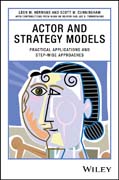
Actor and Strategy Models: Practical Applications and Step–wise Approaches
Hermans, Leon M.
Cunningham, Scott W.
A practical how–to guide for more effective planningthrough multi–actor modelling Careful planning is the cornerstone of a successful initiative, and any plan, policy, or business strategy can only be successful if it has the support of different actors. These actors may beactively pursuing their own agendas, so the plan must not only offer an optimal solution to theproblem, but must also fit the needs and abilities of the actors involved. Actor and Strategy Models: Practical Applications and Step–wise Approaches provides a primer on multi–actormodelling, based on the fundamental premise that actor strategies are explained by investigatingwhat actors can do, think, and want to achieve. Covering a variety of models with detailed background and case examples, this book focuses on practical application. Step–by–step instructions for each approach provide immediately actionable insight, while a general framework for actor and strategy modelling allows the reader to tailor any approach as needed to optimize results in terms of situation–specific planning. Oriented toward real–world strategy, this helpful resource: Provides models that shed light on the multi–actor dimensions of planning, using a variety of analytical approaches Includes literature, theoretical underpinnings, and applications for each method covered Clarifies the similarities, differences, and suitable applications between various actor modelling approaches Provides a step–wise framework for actor and strategy modelling Offers guidance for the identification, structuring, and measuring of values and perceptions Examines the challenges involved in analyzing actors and strategies Even before planning begins, an endeavor?s success depends upon a clear understanding of the various actors involved in the planning and implementation stages. From game theory and argumentative analysis, through social network analysis, cognitive mapping, and beyond,Actor and Strategy Models provides valuable insight for more effective planning. INDICE: Preface .Acknowledgements .List of Figures .List of Tables .List of Textboxes .PART I: INTRODUCTION .Chapter 1: The need for actor and strategy models .1.1 Actors and decision making .1.2 Applications of actor and strategy models .1.3 Scope and structure of this book .References .Chapter 2: A framework for actor and strategy modelling .2.1 What are strategic actors? .2.2 Conceptual framework for strategic actor interactions .2.3 Overview of actor and strategy models .2.4 Step–wise approach for actor and strategy modelling .2.5 Challenges in modelling strategic actor interactions .2.6 Summary and further reading .References .PART II: MODELS AND APPLICATIONS .Chapter 3: Scanning your actor network as part of problem diagnosis .3.1 Diagnosis for strategic interaction problems .3.2 Stakeholder analysis and actor network scanning .3.3 Step–wise approach for actor network scanning .3.4 Case application: Offshore wind energy .3.5 Summary and further reading .References .II–A VALUES .Chapter 4: Identifying, structuring and measuring values: Value–focused thinking .4.1 Values as fundamental drivers of actor processes .4.2 Value–focused thinking for multi–actor issues .4.3 Step–wise approach for value–focused thinking for multiple actors .4.4 Case application: Rural livelihoods in Tanzania .4.5 Summary and further reading .References .II–B RESOURCE DEPENDENCIES .Chapter 5: Making a move: Analysis of options and conflict graphs .5.1 Strategic use of resources to shape environments .5.2 Analysis of options .5.3 Step–wise approach for analysis of options .5.4 Case application: Volunteered geographical information .5.5 Case application: Solar power .5.6 Summary and further reading .References .Chapter 6: Appraising the strategic value of information: Extensive games .6.1 The role of resources and information in strategic games .6.2 Game theory and social dilemmas .6.3 Step–wise approach for extensive games .6.4 Case application: Supply chain management .6.5 Summary and further reading .References .Chapter 7: Looking for coalitions: Cooperative game theory .7.1 Group capability and cooperation .7.2 Cooperative game theory .7.3 Step–wise approach for analyzing cooperative potential .7.4 Case application: Renewable energy .7.5 Summary and further reading .References .Appendix: R Code to Support Cooperative Analyses .Chapter 8: Identifying opportunities for exchange: Transactional analysis .8.1 Multi–actor decision making as an exchange of control over resources .8.2 Transactional analysis .8.3 Step–wise approach for transactional analysis .8.4 Case application: Rural water management in the Netherlands .8.5 Summary and further reading .References .Appendix A: Calculation of dependencies .Appendix B: Calculation of equilibrium control .II–C PERCEPTIONS .Chapter 9: Capturing problem perceptions: Comparative cognitive mapping .9.1 How perceptions can help explain (in)activity in multi–actor settings .9.2 Comparative cognitive mapping .9.3 Step–wise approach for comparative cognitive mapping .9.4 Case Application: Pollution control for urban public spaces .9.5 Summary and further reading .References .Chapter 10: Reconstructing debate: Argumentative analysis .10.1 Debates fuelled by competing claims .10.2 Argumentative analysis .10.3 Step–wise approach for argumentative analysis .10.4 Case application: Watershed protection in the Philippines .10.5 Summary and further reading .References .II–D NETWORKS .Chapter 11: Scrutinizing relations that shape actions: Social network analysis .11.1 The importance of relations between actors .11.2 Social network analysis .11.3 Step–wise approach for social network analysis .11.4 Case application: Innovation network for Internet video services .11.5 Summary and further reading .References .PART III: COMPARISON AND REFLECTION .Chapter 12: Actor models: Comparison and reflection .12.1 When to use what model? .12.2 Illustrative comparison of the use of models for a single case .12.3 Revisiting the challenges involved in analyzing actors and strategies .12.4 Next steps in the future of actor and strategy models .References .Index
- ISBN: 978-1-119-28470-3
- Editorial: Wiley–Blackwell
- Encuadernacion: Cartoné
- Páginas: 400
- Fecha Publicación: 09/03/2018
- Nº Volúmenes: 1
- Idioma: Inglés
